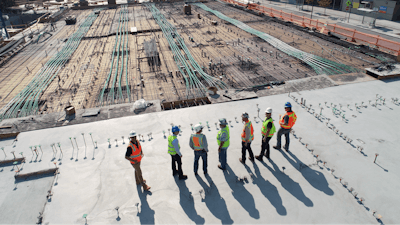
Eighty percent of construction firms report they are having a hard time filling hourly craft positions that represent the bulk of the construction workforce, according to the results of an industry-wide survey by Autodesk and the Associated General Contractors of America (AGC). Association officials said the industry was taking a range of steps to address the situation but called on federal officials to takes steps to assist those industry efforts.
“Workforce shortages remain one of the single most significant threats to the construction industry,” said Stephen E. Sandherr, AGC’s chief executive officer. “However, construction labor shortages are a challenge that can be fixed, and this association will continue to do everything in its power to make sure that happens.”
Of the nearly 2,200 survey respondents, 80% said they are having difficulty filling hourly craft positions, Sandherr noted. All four regions of the country are experiencing similarly severe craft worker shortages, with 83% of contractors in the West and South reporting a hard time filling hourly craft positions, almost identical to the 81% rate in the Midwest and 75% rate in the Northeast.
Read Next: Construction Employment Slows Down in July
Seventy-three percent of firms report it will continue to be hard, or get even harder, to find hourly craft workers over the next 12 months. One reason for their worries is that contractors are skeptical of the quality of the pipeline for recruiting and preparing new craft personnel. Forty-five percent say the local pipeline for preparing well-trained and skilled workers is poor. And 26% say the pipeline for finding workers who can pass a drug test is poor.
Survey: What Do Young Americans Really Think About Trade School?
Labor shortages are prompting many firms to boost pay and compensation. Two-thirds of firms report they have increased base pay rates for craft workers. And 29% report they are providing incentives and bonuses to attract craft workers. Firms are also taking a greater role in developing their own workforce. Forty-six percent report that have launched or expanded in-house training programs and half report getting involved in career building programs.
Read Next: Let's Talk Training, Again
“Construction workforce shortages are prompting many firms to innovate their way to greater productivity,” said Allison Scott, head of construction integrated marketing at Autodesk. “As the cost of labor continues to increase and firms look to become even more efficient, technology can enable better collaboration and ultimately lead to more predictable outcomes. There is also opportunity in untapped pools of talent such as tradeswomen, veterans, and young people looking for an alternative to the traditional four-year university.”
Read Next: Hiring Ex-convicts on the Table to Fill Open Construction Jobs
Scott noted that 29% of firms report they are investing in technology to supplement worker duties. One-fourth of firms report they are using cutting-edge solutions, including drones, robots and 3D printers. Meanwhile, 23% of firms report they are taking steps to improve jobsite performance by relying on lean construction techniques, using tools like Building Information Modeling and doing more off-site prefabrication.
Read Next: Are Human Robots the Future of Construction?
Even as the industry works to address labor shortages, 44% of firms report they are increasing construction prices and 29% are putting longer completion times into their bids for new work because of the lack of workers, putting future development and infrastructure projects at risk. Association officials called on the federal government to boost funding for career and technical education. They also called on federal leaders to allow more immigrants to enter the country to work in construction, let construction students at community and career colleges qualify for federal Pell Grants, and make it easier for firms to establish apprenticeship and other training programs.
Click here to see the national survey results, analysis of the data and regional and state-by-state results.
















